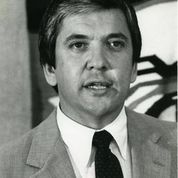 After hustling NCAA coaches into a $50 million Ponzi scheme, J. David Salinas committed suicide in July rather than face the music
After hustling NCAA coaches into a $50 million Ponzi scheme, J. David Salinas committed suicide in July rather than face the music
On the morning of July 15, a Coast Guard patrol discovered a despondent J. David Salinas – the legendary Texas youth basketball benefactor turned investment manager – drifting aimlessly on his jet ski in the bay off Galveston. Under investigation by the Securities and Exchange Commission for peddling more than $50 million worth of phony bonds to a Who’s Who of collegiate basketball coaches – including Arizona’s Lute Olsen and Texas Tech’s Billy Gillispie – and wealthy families across the country, Salinas had decided to kill himself.
For decades Salinas, 60, had been celebrated by coaches, players, parents, community leaders and the press as a pillar of the community. Not only had Salinas helped launch dozens of promising players into top college teams around the nation as the founder of the Amateur Athletic Union’s (AAU) elite Houston Select basketball team, but he was a Texas business leader who made his network of contacts solid returns through his investment funds, J. David Group and J. David Financial.
But less than two days after he was pulled out of Galveston Bay and then sent home by hospital authorities, Salinas put a gun to his head and pulled the trigger.
In the wake of Salinas’ suicide, the details of his apparent long-running Ponzi scheme sent tremors through the world of college basketball and his high-net worth victims who had believed in the man’s integrity. “Salinas was a close friend and somebody I thought we could trust,” one college hoops coach was quoted as saying. “The hardest part for me was knowing I was deceived for so long.”
“I can’t believe this happened,” another coach said, “He’s about the last guy I would’ve figured would do something like this.”
Within weeks, Sports Illustrated published “The Man With A Scam,” an expose that painted Salinas as a man leading a life of seductive wealth (replete with Bentleys and private jets) who threw lavish parties for coaches and possessed a persuasive charm, a man who understood the power of networking and nurturing relationships-even if it was to the devious ends of the long con.
Clearly, Salinas had used his good name and reputation to convince his victims to invest their money – in some cases millions of dollars – in his funds. “He had a great reputation as a strong money manager, not just locally but nationally,” a source close to the case told the media. “People are shocked. A lot of these investors were his friends. There’s a feeling of, ‘How do you know what’s safe?’”
“We didn’t scrutinize David because of the influential people around him,” another source close to Salinas told SI. “He’s done this for over 20 years. [We assumed] that these people had vetted him, so we didn’t feel the need to.”
It is human nature to want to believe in business associates or community leaders. And most of the time the faith is warranted. But even the most experienced investors are learning at their peril to embrace the credo “trust but verify” and conduct appropriate due diligence before making financial commitments to investment funds, partnerships or joint ventures. Unfortunately, its often difficult to learn the lesson until you become a victim. As in most fraud schemes, the obviously red flags such as not providing audit financial statements become more glaring in retrospect.
While Salinas was not a registered investment advisor, he was well-established insurance broker who specialized in college athletic programs. According to press reports, by the late 1990s Salinas had ventured into money management, tapping Brian A. Bjork, then in his early 30s, to run the company.
In August 2011, the SEC filed a civil action against Salinas’ estate, Bjork, and their companies, outlining how the men defrauded investors through two securities schemes, the first of which dates back at least to 2004 and ultimately took more than 100 investors for nearly $40 million. In the late summer of 2007, the men offered a second scam that raised another $13 million from more than 50 investors, according to the federal complaint.
“Bjork and Salinas promised investors safe, fixed income by investing in highly rated corporate and other bonds with annual yields up to 9%,” the SEC’s complaint stated. “In reality, the J. David Group corporate bond offering was bogus.” [The defendants] provided investors account statements reflecting investments in bonds that, in truth, did not exist or that neither [company] ever acquired as promised.”
Timothy McCole, the SEC attorney prosecuting the case, said that Salinas’ ability to line-up a group of marquee NCAA coaches as investors had something of a reassuring effect on other investors. “The thought probably was ‘Hey, these coaches are invested in this, and they have financial savvy and the wherewithal to know if it’s good. So if it’s good for them it will be good for me,’” McCole said.
Kevin Maley, a Houston businessman that owns a pipe trading company in the oil and gas industry, described to prosecutors how Salinas and Bjork met him together over a lunch in early 2004 and convinced him to invest in a firm known as J. David Financial. In 2007, Bjork told him that he was forming a new entity called Select Asset Management (SAM), that Salinas was investing $20 million of his own money into the venture, and that the new firm would provide better financial returns than J. David Financial.
Maley stated that while he never invested in SAM or authorized transferring his funds from J. David Financial into the new group, Bjork simply moved the money anyway. “As best I recall, I just began receiving account statements on SAM letterhead instead of J. David letterhead,” Maley stated. And once the funds were transferred to the new company, Bjork significantly increased Maley’s investment in bonds. In December of 2006, Maley stated his bond investments through J. David Financial were approximately $670,000. By March of 2011, Maley was receiving statements from SAM that showed he had $3.5 million invested in bonds.
Unfortunately, it seems, this investment profile was largely fabricated from whole cloth.
In late 2009, Maley attempted to use the bonds as collateral for a business loan from Amegy Bank, but the bank immediately raised concerns about the legitimacy of the bonds. After Bjork provided him with the bonds’ CUSIP numbers (coding from the Committee on Uniform Securities Identification Procedures), Maley said the bank pointed out further discrepancies in the bonds listed and actual bonds, including their market value.
Maley decided to confront Bjork in person.
“Bjork met with me and told me that Salinas was able to buy the bonds in bulk and distribute them among his clients, providing them a much greater rate of return,” Maley stated. “He told me there had been an audit and there was nothing to worry about.”
Another witness, hedge fund analyst Scott Jackson, stated that his 90-year-old grandmother had sunk $900,0000 into SAM. After reviewing her SAM statements, he became concerned that “the rates of return seemed too good to be true.”
Scott also describes personally confronting Bjork, a meeting that quickly became heated. “When I pressed him further, Bjork became very agitated and suggested I was simply uninformed about bonds,” Jackson stated in a declaration to the SEC. “In fact, he asked me ‘Scott, do you trade bonds?’ I said no, but that I understand how bonds work and further that the yields for the bonds on my grandmother’s statement did not add up. Bjork persisted that the values were correct.”
Along with the crafty verbal claims and representations made by Salinas and Bjork to their investors, federal investigators reported that the duo promised but never produced the quarterly unaudited balance sheets and independently audited annual financial statements stated in its portfolio management plans (PPMs).
“I think it would be fair to say that the victims in this case faced misinformation that put them at a distinct disadvantage,” said McCole. “The misinformation used to perpetrate this fraud may well have hindered efforts at performing due-diligence.”
The SEC complaint against Salinas and Bjork continues to reverberated throughout college athletic departments from Gonzaga to Nebraska to Texas A&M as the list of basketball coaches who invested some $8 million in the Ponzi scheme grows.
Some serious questions are being raised whether Salinas enlisted these coaching staffs into a quid pro quo of investing in his funds in return for Salinas directing his players to commit to their schools? At least 10 players from Salinas’ Houston Select had committed to colleges with Salinas investors, according to news reports.
Houston coach Tom Penders told the media that Salinas wasn’t shy about drawing a connection between the athletic recruiting and the investments he wanted to see made by coaches. During a pitch to get Penders to sink $100,000 into an investment pool with another nine coaches, Penders said Salinas reminded him of all the players he’d sent to Houston and said “I can really help you.”
“He talked about all these coaches that he had investing with him,” Penders told The Daily website. “I told him because he was an AAU guy, I couldn’t possibly get involved in that. I said, ‘I think that’s kind of a rules violation, or could be.’”
A court-appointed receiver is now wading through the records of J. David Financial and Select Asset Management, attempting to determine how much of the $53 million in invested funds might be recovered. However, as David Salinas’ suicide suggests, the answer to that question may not be a happy one for anyone involved.


 After hustling NCAA coaches into a $50 million Ponzi scheme, J. David Salinas committed suicide in July rather than face the music
After hustling NCAA coaches into a $50 million Ponzi scheme, J. David Salinas committed suicide in July rather than face the music